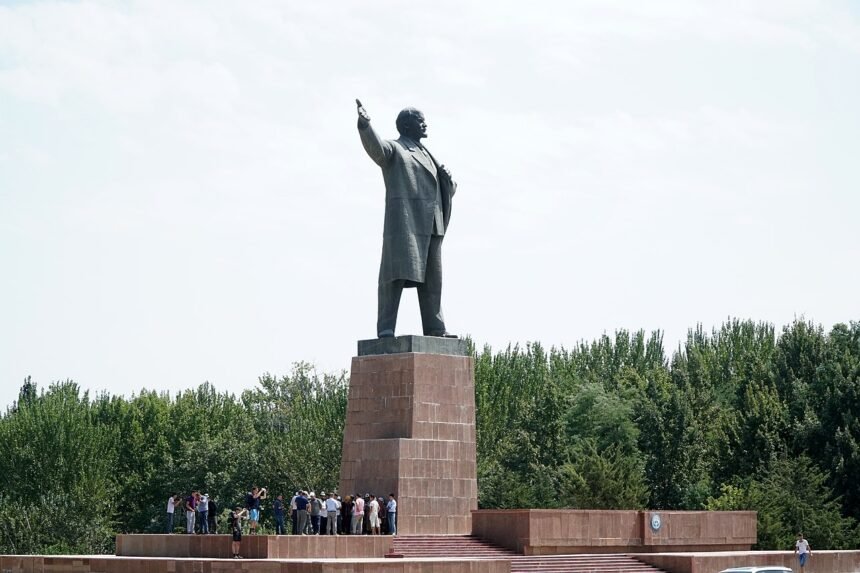Kyrgyzstan: PonteSud – News Desk
For 50 years, a 23-meter, 7.5-ton statue of Vadimir Lenin swept his arm out over Kyrgyzstan’s second city of Osh from a perch above the central square. Then one morning, he disappeared.
Residents of the city of 300,000 woke up June 7 to find that municipal authorities had the statue, considered to be the tallest Lenin monument in Central Asia, taken down, according to Kaktus, a Kyrgyz media outlet.
The move came as a surprise to many residents and only a few passersby managed to snap photos of workers using a crane to dismantle the statue in the wee hours.
The statue’s removal and the reaction reflect both the Soviet Union’s complex legacy in Kyrgyzstan, where Soviet symbols and nostalgia remain more prominent than in other ex-republics, and the uptick of Kyrgyz nationalist sentiment in a multi-ethnic country.
The office of recently appointed Osh Mayor Zhenishbek Toktorbaev did not give a reason for the timing of the statue’s removal, but said it will be relocated to Meerim Park, not far from Lenin’s former location. The statue will be replaced with a 95-meter-tall flagpole with a Kyrgyz flag.
“This is a regular practice aiming to improve public architecture and the aesthetic appearance of cities. So, it’s not worth politicizing this issue,” city authorities said in a statement, pointing to Russian authorities’ decision to remove Lenin statues in Saint Petersburg and Belgorod.
The Central Committee of the Party of Communists of Kyrgyzstan expressed outrage, saying the removal “trampled the law and morals” in a June 7 communiqué signed by its leader Izhak Masaliev, also an MP.
“Personalities who consider themselves cultured and educated pulled down a statue to a person thanks to whom millions of Kyrgyz actually became cultured and educated,” the communique stated. It also said party members intend to ask prosecutors to investigate the matter.
Nostalgia for the Soviet era has run strong in Kyrgyzstan, though whether that’s abated in recent years is unclear. Sixty-one percent of Kyrgyz considered the breakup of the USSR more harmful than good, a 2013 Gallup survey found. Only 16 percent saw benefit in the breakup.
The Lenin statue in the capital Bishkek was moved back in 2003. It now stands behind the national museum across from the Foreign Ministry building in downtown Bishkek, having been moved there from the city’s main square.
The Osh removal comes amidst an upswing in Kyrgyz nationalism. President Sadyr Japarov, for instance, has nationalized a Canadian-run gold mine and ordered the reworking of the national flag and anthem while there have been repeated, if limited, efforts to promote the Kyrgyz language over Russian in parliament.
However, relations between Kyrgyzstan and Russia remain strong, though there have been several hiccups of late. Two months ago, Russian security forces raided a Moscow bathhouse principally frequented by Kyrgyz labor migrants, during which Russian authorities repeatedly beat and humiliated the mostly naked men, sparking outrage in Kyrgyzstan.
Days later in Osh, Kyrgyz authorities arrested an employee of the Russia-backed cultural center there and an employee in the mayoral administration for allegedly working to recruit Kyrgyz nationals to fight in Ukraine.
In Russia, State Duma Deputy Alexei Zhuravlev said Lenin’s removal in Osh was “surprising” for a country “that says they are our ally.”
“You know, everything in Ukraine started with an fight against the Soviet legacy, and it’s worth keeping in mind for everyone following such a path,” the deputy chair of the Duma’s Defense Committee told a Russian news site June 9.
Alun Thomas, a political scientist at the University of Staffordshire in the U.K., warned against reading too deeply into the Russian angle in a June 7 interview on the BBC World Service. Thomas noted that the Osh Region has a diverse population – a large chunk of which is ethnically Uzbek – and a history of inter-ethnic conflict, including deadly clashes in 2010 and 1990.
Swapping Lenin out for a national symbol is perhaps intended not to send a message to Russia, but to assert Osh’s Kyrgyz identity, Thomas said.
“For people who don’t necessarily identify as Kyrgyz who live in and around Osh, I think they’ll just be looking very carefully at who comes after Lenin,” he said. “Because for the majority of the population, Lenin was a kind of easy default setting.”







